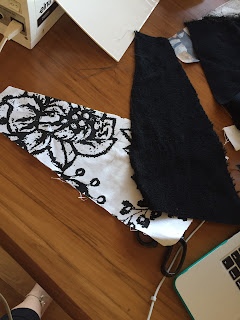So I went shopping the other day to a fabric store (I had to buy some fabric for a laptop case and some birthday presents that I'm planning on making), and while I was there I found the coolest lace in the remnants bin. In my usual fabric shop, the remnants bin is full of amazing finds, I know this isn't always the case, sometimes the bits in their are obviously off cuts from a product that someone has bought and their is hardly enough to make a sock. But I still think that they are worth a look! I have found some great small off cuts in those bins that I am planning on using as coloured accents on bags and shirts and skirts and all the other fun stuff I plan on making.
So this is the $5 lace I bought! There is a heap of it! which is exciting.

my fabric
So with the lace, I decided I wanted to make a vest/ shawl thingy that I can wear over the top of outfits. I already have a black one, and I figured that I could try and use it as a pattern to make a new one!

my purchased one
So I laid out the black one first, just to see what I was working with. I then put my lace down on the bottom, and put the middle panel of the black one on top.

laid out on the table
Next I cut around the outside of half of the black one, moved the black one away, folded my lace in half and cut out the remaining half using my lace as the pattern (this way I knew they were exactly the same).

my back piece!
Next I took the same approach to do the front. Laid out my lace, put one of the front piece on top, and cut it out. What I did differently is I didn't cut out the arm dip part. I laid my piece on top of my back panel so that my arms would be the same. This part didn't exactly go to plan.


As you can see, I lined up my bottom but my top part was a bit off... as in it was no way near connecting to the shoulder part. So I went to plan B.
Plan B was cutting out the same width as I started with or Plan A, but instead of the fancy curve that you can see in the picture above, I just cut straight up the line. Next I pinned my 2 panels (for the front of my vest) to my back piece, and cut it to line up with the side. This meant that I know that my pieces will fit together as perfectly as my cutting skills allow.
Next I had to pic a thread that matched, well I attempted too. It was like "the dress" all over again.
Because I am cheap, I didn't buy any thread to match in the shop I just chose from what I had at home.
Once I had picked my thread, I did a quick google search, as I wasn't overly confident with sewing lace (as in I had never sewn it before), check out my pinterest board for tips! I ended up using a zig zag stitch to sew my edges. Once I sewn it up, I tried it on, trimmed threads and shaped the front panels to make them look not like straight lines (which I literally did with scissors in front of a mirror).
And I ended up with this!
Personally I think its cool! I might, at a later date add sleeves, to make it more versatile (there are certain places like my work where I need to have my shoulder covered). I am also thinking about putting bias tape over all the edges (bias tape is a strip of fabric that you can use to cover edges to give them a line).
So some tips!
- If you are going to splurge on lace, definitely get thread to match. If I add sleeves to this, and particularly bias tape, my seams are going to stand out because I was too cheap to buy thread.
- Use your off cuts to practice sewing on the fabric, and working out which stitch works best for the fabric you have. It happens that for me zig zag worked fine. But if you gaps are bigger than maybe that won't work for you.
- Watch out for your feet and the holes in the lace. When I first read this I scoffed. Then (in my practice piece) I got it stuck.
- Don't be freaked out! I'm a relatively novice sewer, this was my first time sewing on lace and I whipped it up in less than a spotify playlist, including technical difficulties (not sure how long it took me, I just know I didn't listen to a song more than once!)
If you want a pattern, or better instructions, than holla at me in the comments. I'd love to here what you think of this! So comment at me!
Till next time!
Dat Girl

































